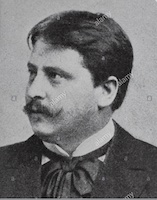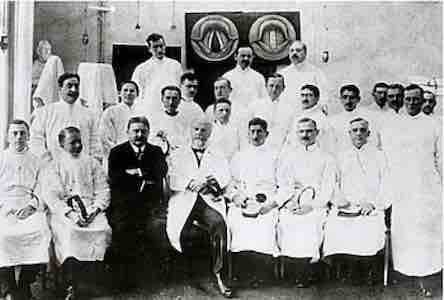Hermann Gutzmann, Senior
1865-1892

Hermann Gutzmann Sr. has been considered by many to be the father of speech pathology, a field known in Europe as phoniatrics (voice) and/or logopedics (speech) (Kuczkowski, et. al. 2014; Froeschels, cited in Lahey, 2021). He developed his interest in speech disorders and therapy from his own father, Albert Gutzmann, who was a teacher of the deaf and mute and who wrote a book on the nature and therapy approaches for stuttering. His doctorate, completed in Berlin in 1887, was entitled: About stuttering.
In 1891 Gutzmann opened a private outpatient clinic that evolved, in 1896, into a specialty speech clinic. Around this time Gutzmann founded a journal reviewing studies and events having to do with medicine and speech/language disorders, called Vox.
His therapy and research related to the relationship between breath movements and speech language disturbances. Gutzmann ran a school, called the Berlin School for Speech and Voice Therapy, where he trained students in therapy and diagnostic methods. His students came from the international community, as well as from Germany. They included Nadoleczny and his son Hermann Gutzmann Jr., both of whom were to make significant contributions to the field of speech disorders.
In Gutzmann’s book, Child’s speech and speech disorders (1894), he offered therapy suggestions for mothers of children with speech disorders. He argued that school teachers and physicians should work together to design speech therapy services for children. In 1905 his lecture on “Speech disorders as a part of clinical studies” led to the establishment of speech and voice pathology as an academic discipline within medicine in University of Berlin’s medical school.
In 1912, Gutzmann was appointed professor of an ENT clinic at the Charite Hospital, a teaching hospital affiliated with the University of Berlin. There he taught courses in phoniatrics (speech pathology) at Charite and at his private practice. The courses include speech physiology, speech hygiene, and speech disorders of school-aged children.
Gutzmann drew from the research of the diagram makers such as Carl Wernicke who preceded him, as is evidenced from the following description by Emil Froeschels on Gutzmann’s theorizing about brain localization:
It may be assumed that the supposed center of higher order from which inner language, or diction, depends, dominates a number of centers of a lower order. These, in turn, are forcing other centers still further below them to joint or isolated action. Thus, a voluntary act of inhaling, interrupting the automatic breathing in the state of rest, must be interpreted as depending from a center in the frontal cortex. Consequently, there has to be a center for voice production which obviously does not simply govern the adduction and abduction of the vocal cords, (since this alone does not lead to voice production), but also at the same time forces the cortical breathing center to cooperate. A center of still higher order will finally have to set the articulation movements in motion, starting from the individual focal points of the speech nerves, sometimes with and sometimes without the utilization of voice.... Each complete cortical motor aphasia therefore consists of two components, a dysphasic and a dysarthric one (Froeschels, 1966).
Gutzmann’s stuttering therapies were based on his interest in the relationship between breath movements and speech language disturbances. One of his clients, Henry Freund, who became a well-known specialist in stuttering in both Europe and America, describes Gutzmann and his son’s therapy as follows:
According to the Gutzmanns, stuttering was a coordination neurosis, and the treatment was designed to accomplish the normal coordination between respiration, vocalization, and articulation. This was accomplished through a specific set of exercises that drilled the stutterer in breathing, vocalizing, and articulating correctly and very consciously, as he first uttered sounds, then syllables, then words and sentences. All words had to be spoken on voluntary exhalation, and the vowels of those words had to be prolonged. Stuttering was forbidden and the discipline was harsh. (Freund, in Van Riper, p. 93).
Gutzmann based his speech therapies for children with language disorders on what he considered to be the etiology of the disorder (adenoid dysfunction, heredity, motor indolence, lack of will to speak (Weiner, 1986). His treatments included removal of adenoids, repetition exercises, and story listening. His repetition exercises were progressive, beginning with syllable repetitions, then syllable strings, followed by lessons in which children associated words and meanings. His most advanced exercises involved repeating grammatical patterns.
Gutzmann’s 1909 monograph ‘‘Voice and speech physiology’’ (Physiologie der Stimme und Sprache) was aimed at phoneticians, linguists, laryngologists, and physicians interested in speech problems.
Gutzman is in the black suit, seated with colleagues at the Charite Hospital.
Gutzmann’s contemporaries placed him in a central role in their depiction of the early history of the profession of phoniatrics in Europe (Lahey, )
Hermann Gutzmann (1865-1922) studied speech disorders from the medical point of view and the services established by him in Berlin, attained world-wide fame. Gutzmann published several books, mainly on the subject of dysphemia, and as his reputation grew, physicians wishing to specialize in the new field of phoniatrics flocked to his clinic. Among these were: E. Scripture, a North American who would later found a Speech Clinic at Columbia University; M. Seeman, founder of the Prague School; A. Liebmann and T. Flatau from Berlin; G. Paconcelli-Calzia from Hamburg; H. Stern from Vienna; and A. Sarbo from Budapest.
Gutzmann established speech and language therapy as an independent medical special field. He published 13 books and more than 300 articles, mostly in German.
References—just a couple from the many
Gutzmann, H. (1894). Child’s speech and speech disorders.
Gutzmann, H. (1909). Voice and speech pathology.

